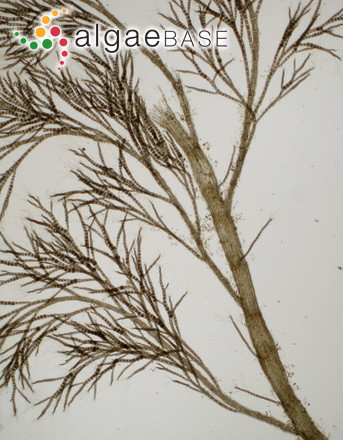Polysiphonia brodiei (Dillwyn) Sprengel 1827

Current name:
Leptosiphonia brodiei (Dillwyn) Savoie & G.W.Saunders
microscope, Spain, Galicia, Ría de Betanzos, 2007Ignacio Bárbara (barbara@udc.es)
Publication Details
Polysiphonia brodiei (Dillwyn) Sprengel 1827: 349 (as 'brodiaei')
Published in: Sprengel, K.[P.J.] (1827). Systema vegetabilium Editio decima sexta. Voluminis IV. Pars I. Classis 24. Vol. 4 pp. [i]-iv, [1]-592. Gottingae [Göttingen]: sumtibus Librariae Dieterichianae.
Type Species
The type species (holotype) of the genus Polysiphonia is Polysiphonia urceolata (Lightfoot ex Dillwyn) Greville.
Status of Name
This name is currently regarded as a synonym of Leptosiphonia brodiei (Dillwyn) Savoie & G.W.Saunders.
Source of Synonymy
Savoie, A.M. & Saunders, G.W. (2018 '2019'). A molecular assessment of species diversity and generic boundaries in the red algal tribes Polysiphonieae and Streblocladieae (Rhodomelaceae, Rhodophyta) in Canada. European Journal of Phycology 54(1): 1-25.
Basionym
Conferva brodiei Dillwyn
Type Information
Syntype localities: "Rocks in the Sea. Near Forres ; James Brodie, Esq. Bantry Bay, Miss Hutchins. At Falmouth ; Mr. Turner. At Scaton, Devon, Mr. Griffiths. Sometimes thrown on the shore at Dover." ; (Dillwyn 1809: pl. 107) Lectotype [Bantry Bay, Co. Cork, Ireland]: Ellen Hutchins; 24.vi.1807; BM; (Maggs & Hommersand 1993: 314) Notes: This type locality was first recorded by Womersley (1979: 497).
Eponomy
Named for James Brodie, Scottish Naturalist; generally misspelled “brodiaei”.
General Environment
This is a marine species.
Description
Cartilaginous, cylindrical, tufted, dark purple-red fronds, to 300 mm long, from small conical basal disc. Branches irregular to pseudodichotomous, densely clothed with short, slender, much-divided branchlets, forming the distinct tufts characteristic of this species. Central siphon of main axes with 6-8 primary pericentral siphons and as many alternating secondary pericentral siphons, surrounded by small corticating cells. Branchlets ecorticate, with fewer pericentral siphons, articulations about as long as broad.
Habitat
On rocks, stones, shells and corallines, mid-intertidal pools to subtidal, especially on exposed shores, generally distributed, common. According to Womersley (2003: 205), this species is usually found in or near harbour areas and may be spreading.
Created: 31 March 1996 by M.D. Guiry.
Last updated: 17 February 2020
Verification of Data
Users are responsible for verifying the accuracy of information before use, as noted on the website Content page.
Linking to this page: https://www.algaebase.org/search/species/detail/?species_id=172
Citing AlgaeBase
Cite this record as:
M.D. Guiry in Guiry, M.D. & Guiry, G.M. 17 February 2020. AlgaeBase. World-wide electronic publication, National University of Ireland, Galway. https://www.algaebase.org; searched on 26 November 2024
 Request PDF
Request PDF














